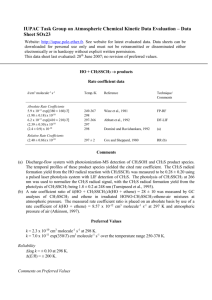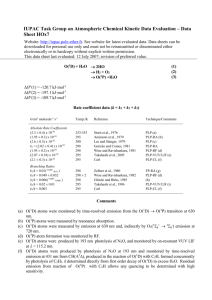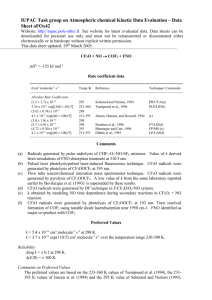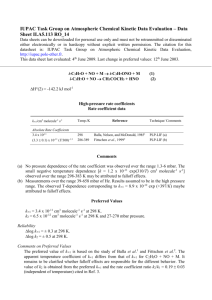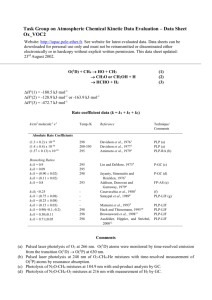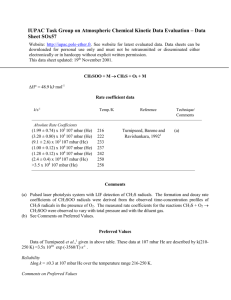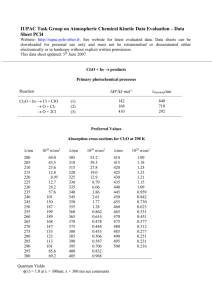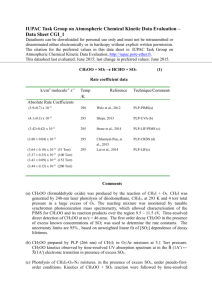Word - IUPAC Task Group on Atmospheric Chemical Kinetic Data
advertisement
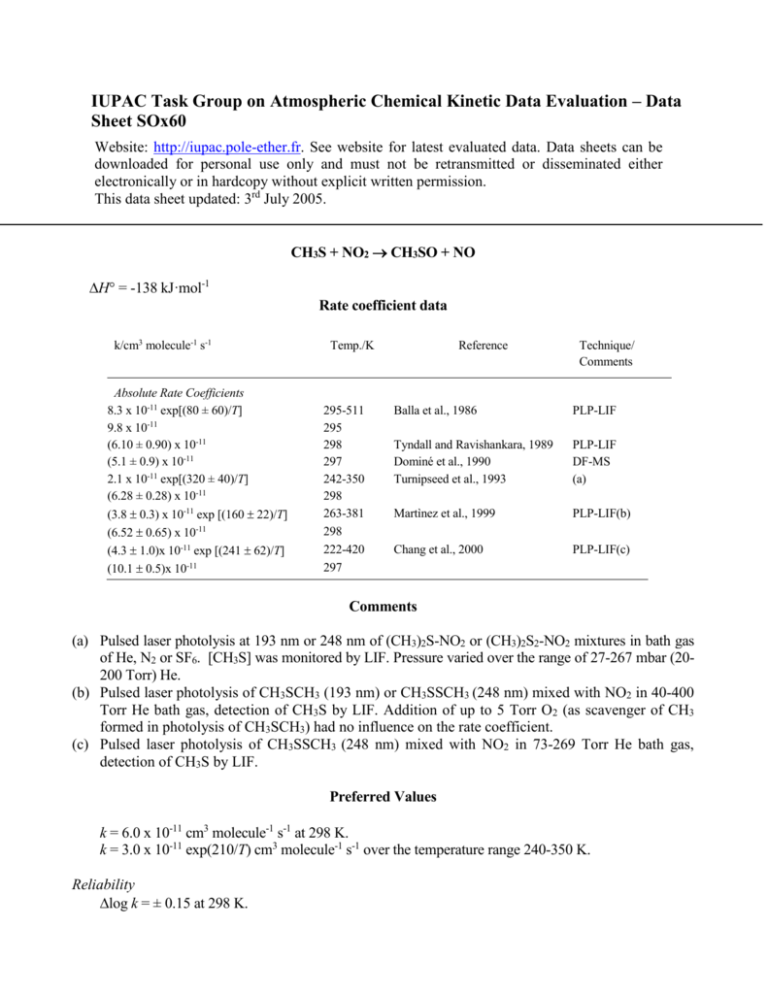
IUPAC Task Group on Atmospheric Chemical Kinetic Data Evaluation – Data Sheet SOx60 Website: http://iupac.pole-ether.fr. See website for latest evaluated data. Data sheets can be downloaded for personal use only and must not be retransmitted or disseminated either electronically or in hardcopy without explicit written permission. This data sheet updated: 3rd July 2005. CH3S + NO2 CH3SO + NO H = -138 kJ·mol-1 Rate coefficient data k/cm3 molecule-1 s-1 Absolute Rate Coefficients 8.3 x 10-11 exp[(80 ± 60)/T] 9.8 x 10-11 (6.10 ± 0.90) x 10-11 (5.1 ± 0.9) x 10-11 2.1 x 10-11 exp[(320 ± 40)/T] (6.28 ± 0.28) x 10-11 (3.8 0.3) x 10-11 exp [(160 22)/T] (6.52 0.65) x 10-11 (4.3 1.0)x 10-11 exp [(241 62)/T] (10.1 0.5)x 10-11 Temp./K 295-511 295 298 297 242-350 298 263-381 298 222-420 297 Reference Technique/ Comments Balla et al., 1986 PLP-LIF Tyndall and Ravishankara, 1989 Dominé et al., 1990 Turnipseed et al., 1993 PLP-LIF DF-MS (a) Martìnez et al., 1999 PLP-LIF(b) Chang et al., 2000 PLP-LIF(c) Comments (a) Pulsed laser photolysis at 193 nm or 248 nm of (CH3)2S-NO2 or (CH3)2S2-NO2 mixtures in bath gas of He, N2 or SF6. [CH3S] was monitored by LIF. Pressure varied over the range of 27-267 mbar (20200 Torr) He. (b) Pulsed laser photolysis of CH3SCH3 (193 nm) or CH3SSCH3 (248 nm) mixed with NO2 in 40-400 Torr He bath gas, detection of CH3S by LIF. Addition of up to 5 Torr O2 (as scavenger of CH3 formed in photolysis of CH3SCH3) had no influence on the rate coefficient. (c) Pulsed laser photolysis of CH3SSCH3 (248 nm) mixed with NO2 in 73-269 Torr He bath gas, detection of CH3S by LIF. Preferred Values k = 6.0 x 10-11 cm3 molecule-1 s-1 at 298 K. k = 3.0 x 10-11 exp(210/T) cm3 molecule-1 s-1 over the temperature range 240-350 K. Reliability log k = ± 0.15 at 298 K. (E/R) = ± 200 K. Comments on Preferred Values The recommended value at 298 K is the mean of the studies of Tyndall and Ravishankara (1989), Dominé et al. (1990), Turnipseed et al. (1993) and Martìnez et al. (1999), which are in good agreement. There are four studies of the temperature dependence of k, all giving a negative value of E/R but differing significantly in magnitude. Two studies, Balla et al. (1986) and Chang et al. (2000) obtained values of k nearly twice as large as those found in the other studies. It has been suggested (Tyndall et al., 1989) that this could result from secondary chemistry arising from the higher radical concentrations used in the work of Balla et al. (1986) though this argument does not apply to Chang et al. (2000). The temperature dependent expression for k is derived by fitting to the data of Turnipseed et al. (1993) and Martìnez et al. (1999) and adjusting for the recommended value of k at 298 K. The CH3SO yield has been determined by Dominé et al. (1990) to be 1.07 0.15; the yield of NO was determined by Tyndall and Ravishankara (1989) to be 0.8 0.2. End product studies (Barnes et al. 1987) are in agreement with this conclusion. Theoretical calculations suggest the intermediacy of a CH3SNO2 association complex (Wang et al., 2002). References Balla, R. J., Nelson, H. H. and McDonald, J. R.: Chem. Phys. 109, 101, 1986. Barnes, I., Bastian, V., Becker, K. H. and Niki, H.: Chem. Phys. Lett. 140, 451, 1987. Chang, P.-F., Wang, T. T., Wang, N. S., Hwang. Y.-L. and Lee, Y.-P.: J. Phys. Chem. 104, 5525, 2000. Dominé, F., Murrells, T. P. and Howard, C. J.: J. Phys. Chem. 94, 5839, 1990. Martìnez, E., Albaladejo, J., Jiménez, E., Notario, A. and Aranda, A.: Chem. Phys. Lett. 308, 37, 1999. Turnipseed, A. A., Barone, S. B. and Ravishankara, A. R.: J. Phys. Chem. 97, 5926, 1993. Tyndall, G. S. and Ravishankara, A. R.: J. Phys. Chem. 93, 2426, 1989. Wang, S. K., Zhang, Q. Z., Zhou, J. H. and Gu, Y. S.: Chin. Chem. Lett. 13, 805, 2002.
